Is there a plant in your garden that you're worried won't survive this brutal winter? For gardeners outside the U.S. and Canada, are you concerned about specific plants in your garden for other reasons?
Lately, my Ornamental Sage plants have been on my mind. I'm not sure why, because they're tough perennials! I don't have the original tags, but I believe mine are either Salvia nemorosa or the hybrid Salvia x superba. They've graced the outer corners of my potager garden for about a decade now, and they've always bounced back every spring like clockwork.
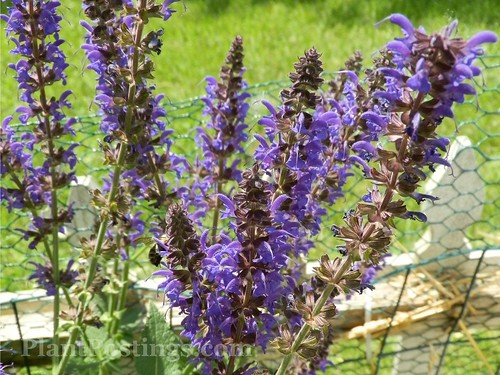 |
| Ornamental Sage in June 2013. |
As soon as they start blooming, the pollinators cover them! I didn't realize until I started cropping the photos for this post that all but two show bumblebees diving in for the Salvias' plentiful nectar! (Can you see them? You can click on the photos to enlarge them.) In fact, it's hard to get a shot of these spikey lavendar/blue beauties without bumbles--not that I've really tried either way.
Ornamental Sages prefer sun, and rich but well-drained soil. They grow to about two feet tall, and form a shrub-like shape. They have a unique scent, similar to other plants in the Mint family, Lamiaceae. And rabbits and deer tend to avoid them.
Why am I worried about these plants? I guess I shouldn't worry because they've survived extreme temperatures and droughts for years. S. nemorosa and its hybrid superba are hardy to zone 5, and some sources say to zone 4. My two clumps are tucked in for the winter with a warm layer of Marsh Hay mulch and soft snow, and they're planted near the house foundation--on the sunny west side of the house.
Still I worry...
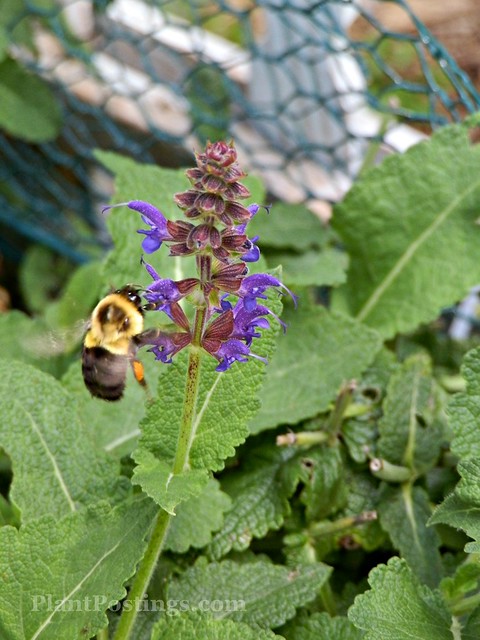 |
| Ornamental Sage in August 2013. After several rounds of deadheading, still plenty of nectar and pollen to go around. |
I can't imagine my garden without them. They've become fixtures--reliable stallwarts that I count on every year.
This "Dummy's Guide" to planting flowers for bees notes that when in bloom, Salvias are "covered with bees all day long." I concur.
In my garden, that means continuous blooms and continuous pollinators from May through August.
But you're more likely to have repeat blooms if you deadhead them. Several times during the season, I spend a little time every few weeks pinching off the spent blooms. I'm not picky, I just grab the garden pruners and start cutting back--usually to the base of each individual stem. Within days, I have blooms again.
I've heard other gardeners say the Ornamental Sages can be floppy. That might be true, but mine are planted with fencing as supports on two sides, and other potager plants on the other sides. And with the regular deadheading, they really don't get floppy at all.
I sure hope they'll be back this spring and summer!
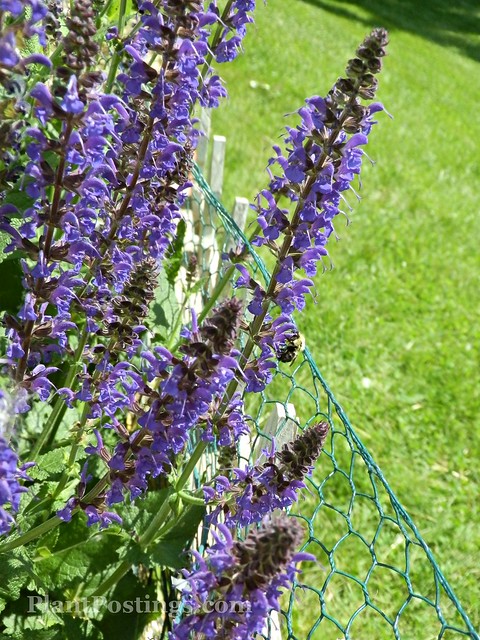
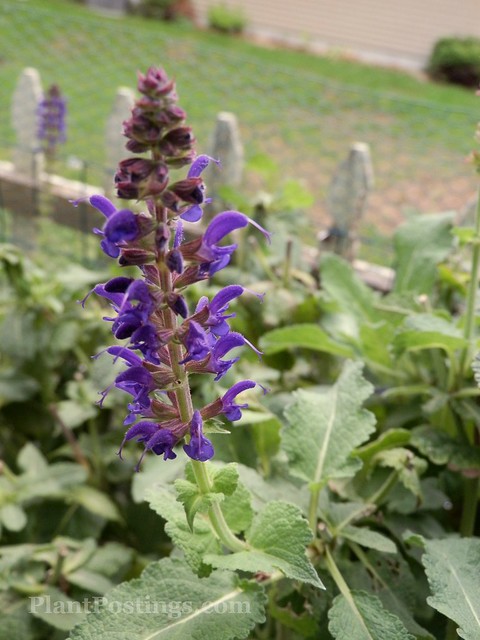
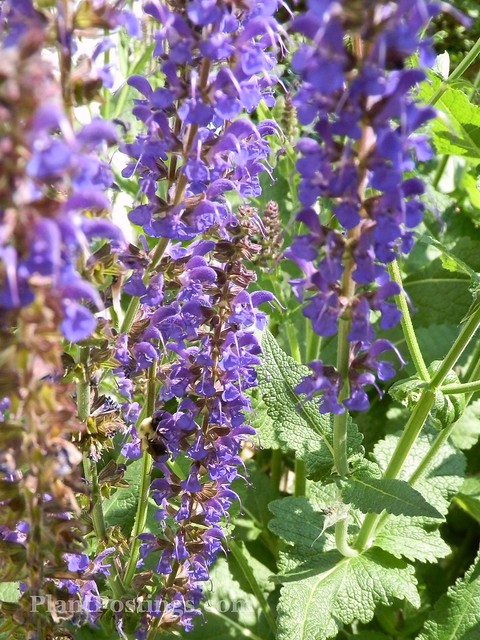
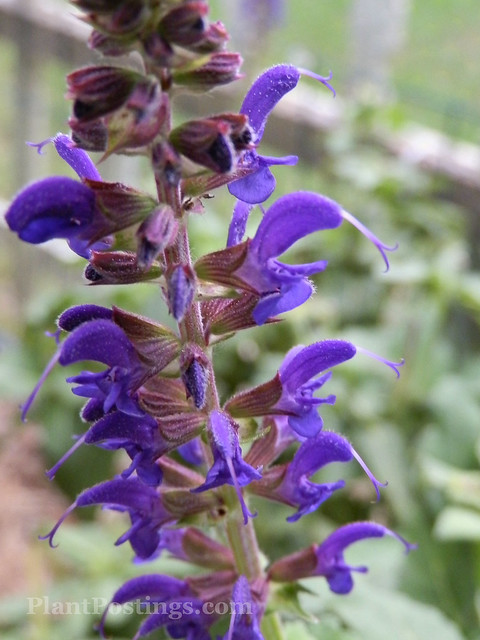
Salvia is one of my favorite plants in the garden. I have 'May Night' and it blooms from late May all throughout the summer with deadheading. The key is to deadhead to keep it full and blooming. I've had mine blooming all the way through October which is why I love it so much. I am sure your Salvia will make it. The snow we have been getting acts as an insulator and the cold is good for root development. Usually when we have a cold winter the perennials do even better. Can't wait for spring...it's way too cold! Stay warm!
ReplyDeleteThanks for the encouragement, Lee. I'm sure you're right. I expect to lose some tender plants in this crazy arctic winter. But the Salvias should be fine, they are so hardy. Thing is, I just realized how I take them for granted! I guess that shows how hardy they are! And yes, the snow is certainly a blessing of protection this winter!
DeleteI love sages for the way they attract butterflies, bees, and even hummingbirds, as well as their durability.
ReplyDeleteI imagine the hummers like them, too. Mine aren't near a window or a place where I can sit quietly to watch (hard to explain), so I never catch the hummers on them. But I've definitely seen butterflies and bees buzzing on them--almost constantly!
DeleteOh I totally understand plant worry...and I hope that both of our gardens weather this and every winter.
ReplyDeleteI have a beautiful ornamental sage, and each spring I snitch a bit for another area.
Jen
Perennials are incredible, aren't they? Especially the ones that can endure extreme heat, drought, deep freeze, and everything in between! I hope our gardens pull through, too, Jen!
DeleteThat is a beautiful salvia, and I hope it survives and blooms again for you. I lose a few marginally hardy plants almost every year, such as some fuchsias, a salvia confertiflora, some scented geraniums...
ReplyDeleteThanks for the well-wishes, Masha. You are so fortunate to have those blooms through the winter! It's almost enough to convince me to move to California! ;-)
DeleteI also love various blue and purple ornamental sages. I do have problems with flopping, and have tried a variety of tactics to deal with that. There is also a native sage called Salvia azurea that I'd like to try.
ReplyDeleteYes, I guess the flopping can be a problem. But the fencing, tight planting, and deadheading pretty much eliminate that issue for me--at least where I have them planted right now. I'll have to do some research on S. azurea. Thanks!
DeleteI can't get these to survive in my garden. I think my soil is just too wet in the winter. I can grow the culinary varieties just fine but not these guys. Weird. They're so pretty and I love that they attract bees.
ReplyDeleteOh, I guess I did read something about wet soil being a problem. All the literature says the soil should be well-drained. Mine is planted on a hill that drains away from the house, so that seems to work well. I'm always amazed at how the pollinators cover them!
DeleteI love sages too and these Salvia nemerosa/Salvia x superba are doing quite well in my wet and sometimes very cold Dutch garden, the worst thing is when you get frost when the soil is wet, then perennials get problems to survive. In my garden I have one sage to worry about, the Salvia guaranitica. It is a beauty but not so hardy, so I have covered it with leaves and branches.
ReplyDeleteAh, good to know that they work well in Holland, too. I think standing water on top of soil can be a problem here, too. My soil seems to suck the rain in very deeply most of the time. There are a few spots, though, where I think perennials might have a problem establishing. Right now, all I have in those spots is grass. I'm going to research S. guaranitica because I'm curious. ;-)
DeleteHi Beth, i love blues and violets, wish it thrives in our hot climes. In our case here, i am worried that many plants most specially my hoyas might not be able to withstand the long dry season, as they say it would be longer as global warming heightens.
ReplyDeleteGood luck with your Hoyas! Long droughts are so difficult. I've only been through two that I can remember, and it was horrible! Heat with rain is one thing, but heat with no rain for weeks on end ... that is a nightmare for a gardener, or anyone. Take care!
DeleteOrnamental sages were some of the first plants I ever planted in my garden. I was looking for purple accents, and as your photos demonstrate so well, they certainly provide that gorgeous jolt of purple! I don't worry about mine at all--in fact, the 'Mainacht' I planted in my arbor bed has decided to multiply. One of the first tasks this spring is to dig them all up and plant them in a better spot. I've always wanted a "river of salvia" like the one at the Lurie in Chicago:)
ReplyDeleteThey were among the first plants I put into my current garden here. I can't remember why, but I'm so glad I did! It's such a pretty shade of violet/bright purple, too. I can tell I need to take more trips to Chicago in the months ahead! So many botanical displays to visit! ;-)
DeleteWas looking sadly at my nutmeg geranium. Today is overcast, but I must wait till March - then harvest cuttings and try and encourage new plants.
ReplyDeleteWe are on opposite but complimentary paths, Diana. It's so encouraging to hear about your warmth while we are shivering over here in the northern hemisphere. Sounds like we're both looking forward to March this year!
DeleteI love sage and ornamental sage too. Mine are always covered with pollinators too. I have them in the front garden where it is drier. I don't know why I didn't think of it before, but they grow so well I can divide the mother plant and move them around in the front garden to replace other plants I need to move or get rid of...thanks for reminding me of these incredible sturdy plants Beth!!
ReplyDeleteIf I had more sun, I'd move mine around more, too. Thanks for the encouragement, Donna. I'm sure you're right that they'll be just fine. They do seem to appreciate dry more than super wet locations.
DeleteWorrying is just part of the gardeners lot in life, and most of us have plenty to worry about this harsh winter. May we all come through relatively unscathed.
ReplyDeleteYes, very true Ricki. It will be so wonderful to see the perennials beginning to emerge. I'm trying not to wish away the days this winter. But dreaming and hoping are two of my coping mechanisms. ;-)
DeleteI agree - they are beautiful! I love when the garden is humming with bees... Hopefully they're tough enough to survive the cold. I have a few perennials I'm worried about too...
ReplyDeleteI think they'll be OK. If not, I'll plant more. Dreaming about the bees and other pollinators and looking forward to their return!
DeleteU mnie szałwia nigdy nie była taka wysoka. Pewno inna odmiana. Nie martw się. Opatuliłaś rośliny, przysypał je śnieg i wiosną znowu pięknie Ci zakwitnie. Pozdrawiam.
ReplyDeleteFor me sage never been so high. Probably the other variety. Do not worry. The plants are covered, it still snow covered the spring and again you will bloom beautifully. Yours.
That's true, Giga--the covering of the mulch and snow should keep them safe and warm. :) There are so many varieties of Salvias, so you probably have a different one.
DeleteLovely blue salvia Beth, I can understand you worry about them during a winter like you have right now. I must admit I have never lost any plants to winter weather, only during dry summers. Our winters vary a lot and last winter was one of the coldest I have experienced here, but none of the plants were damaged. Perhaps that means I could grow even more tender plants?!
ReplyDeleteI am pushing things a bit this winter though, having bought a couple of palms and two oleanders, I chose the right winter to get them it seems, they are all doing fine.
Palms and Oleanders--how wonderful! I've had a few plants expire during past winters, but not too many. Or maybe they were too stressed from the summer so they didn't have enough energy to survive the winter. We sure have the extremes here. But, then, I guess a lot of people do. ;-)
DeleteI adore saliva also - any all of them! In fact, nemorosa may be one of the few I don't have in my garden...As you say, they are the absolute best for pollinators. And is it my imagination, or do bees prefer purple flowers in general?
ReplyDeleteThe bees sure look pretty feasting on purple blooms. ;-) Your garden is impressive, Sarah! I'm imagining the pollinators feasting on all your amazing plants.
DeleteI bet they'll be fine! They are super tough. We've had the coldest January in 100 years and I have a few shrubs that might not make it. But I'm not too worried about the salvia. I love that deep blue. So pretty! :)
ReplyDeleteWow--the coldest in 100 years! I hope all your shrubs (and plants), and mine, pull through! I think you're probably right about the Salvia. Thanks for the optimism.
DeleteThey are beautiful, and it's so fun to have a plant that attracts the bees like that. I foolishly bought a couple of small trees that I put in big pots (too heavy to lug into the garage). They are a type of tree that only grows south of us, but I was hoping... And some new perennials that I'm not sure if they are dead or just dormant. Time will tell. I hope your salvias make it through this winter.
ReplyDeleteI hope you're trees and other plants will be OK. This winter is something else! Stay warm!
DeleteWhat a gorgeous colour. I could never grow salvias in my previous garden, the soil was too heavy and I didn't have enough direct sun, so one of the things I have been looking forward to is growing them here, the only dilemma is which to pick! I keep noting ones down, and have no idea how I will eventually pick. Hope yours bounce back as always come spring, when I look forward to seeing those wonderful vivid flowers again.
ReplyDeleteI love the color, too. Anything in the range of french blue to periwinkle to bluish/purple makes my heart sing. I only have one small area sunny enough for them here, but they seem to love it. I think they'll be OK, it's just that I've totally taken them for granted over the years.
DeleteI wish my salvia x superba lived as long as yours! I need to try it in a very well-drained place. It's a lovely plant as your pictures so beautifully illustrate!
ReplyDeleteThank you. I suppose it does help that it's at the top of a hill, so the water naturally drains away from the house. And it's very sunny spot. I hope you can find a good place for it!
DeleteWonderful and easy plant for the flower garden. I have used some of my precious sunny bed for these beauties.
ReplyDeleteI truly miss those precious sunny garden areas during the dark winter. I miss the garden, overall, but I dream of the sunny moments the most. :)
DeleteGorgeous Ornamental Sage images . . . I am fretting a bit about all my favorites buried deep under the snow . . . way deep! I can't imagine how long it will take for all this white to fade/melt away . . . Let's hope all will be well . . .
ReplyDeleteWe northern gardeners have a long time to wait. I guess that is "normal." But after this especially cruel winter, February will be especially tough. At least in March, when some of the snow melts, we'll have some ideas of plants that have survived. :)
DeleteGiven the unusually harsh winter we're having in Georgia, I'm concerned about a number of new plants in my new garden. I have not planted ornamental sage, but I sure look forward to laying some in when the thaw comes. Yours inspire. Beauty and bees too. What's not to love.
ReplyDeleteI know, I keep thinking about all of you in the southeast. Our temperatures have been colder than normal, but not out of the range of what we should expect. But Georgia and the Carolinas have been surprisingly cold! I hope your plans will be OK.
DeleteGosh, it is so cold where you are, I would worry about these beautiful salvias, too! Truly hope that they get through your tough winter! I have planted salvias in my own garden last year for the very first time with good success. The variety is called 'Mystic Spires Blue'. They really did attract the bees and I was so happy about that. They have been proven to be relatively drought tolerant as well. This year I intend to plant some more. Wishing you a nice weekend!
ReplyDeleteChristina
Yes, it has been cold. We're getting a little warmer now, so anything that survived the polar vortex will probably make it through now. Oh, I'll have to watch your posts to see when you feature the Salvias!
DeleteI've nursed a few Salvia x sylvestris through winter for the last couple of years. This year however, I've left them to their own devices! I'm ridding my garden of plants that cause me worry over winter. I can agree they are loved by the bees.
ReplyDeleteMy worry this week, I tend to have a new one every week, is whether or not the Clematis montana I planted back in autumn, ever show signs of life! All my other Clematis (summer flowering) have new growth but the montana is just a little pile of dead twigs!
I agree about avoiding pampering--I generally don't do it, with a few exceptions. But the Salvias are on their own. If they made it through the several blasts of the polar vortex (in addition to the drought we had in 2012), I'd recommend them to anyone in this climate!
Delete